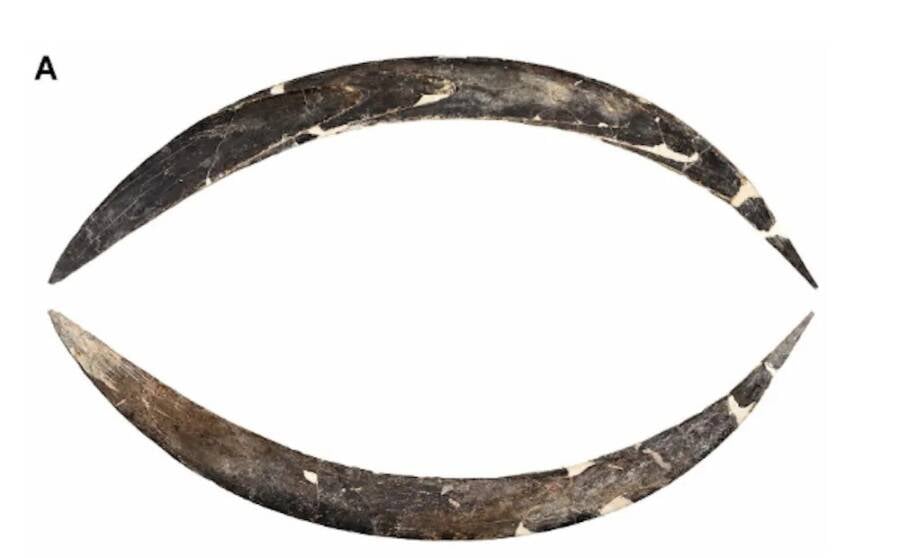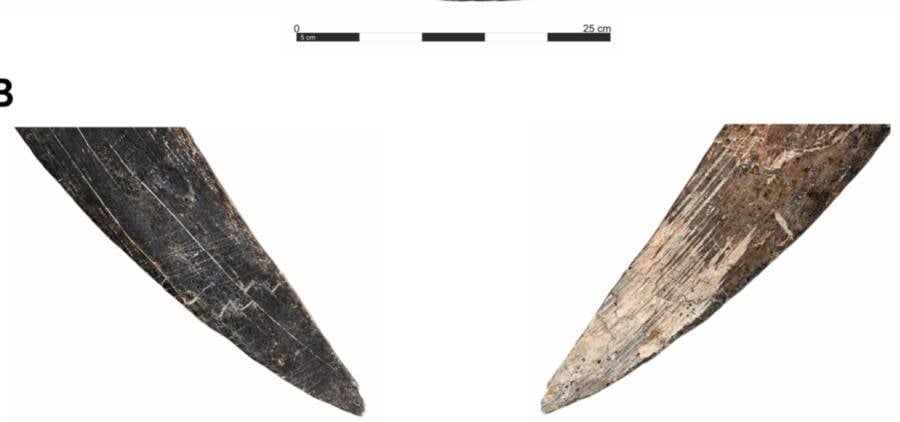The boomerang, discovered in Poland’s Obłazowa Cave in the 1980s, was once believed to be 18,000 years old, but a new analysis suggests it's about 40,000 years old.

Talamo et al., PLOS ONE, 2025The mammoth tusk boomerang was first unearthed in Poland’s Obłazowa Cave in the 1980s.
The prehistoric boomerang found in Poland’s Obłazowa Cave was always an exciting discovery. Unearthed among other objects, including a human thumb bone, the boomerang was originally estimated to be 18,000 years old. That made it thousands of years older than the earliest known boomerangs found in Australia, which are about 10,000 years old.
But there was an issue: The other objects in the Polish cave were much older, leading researchers to believe that the boomerang’s age was incorrect. Indeed, they’ve now found that it’s far older than once thought.
A new analysis of the boomerang, made with the cave’s other objects in mind, has suggested that the world’s oldest boomerang was made by ancient humans between 39,000 and 42,000 years ago.
Calculating And Recalculating The Age Of The World’s Oldest Boomerang

Jerzy Opioła/Wikimedia CommonsObłazowa Cave in Poland, where the boomerang was found in the 1980s.
The revelation about the boomerang’s age was made by researchers in the journal PLOS One. They set out to investigate an enduring mystery about the boomerang, which was found in Obłazowa Cave in the 1980s. Archaeologists also unearthed other objects at the site, including antler tools, pendants made from fox teeth, animal bones, a bone bead, and a human thumb bone.
But while radiocarbon dating in the 1990s suggested that the thumb bone was 31,000 years old, the boomerang appeared to be much younger. To the surprise of the researchers, radiocarbon dating found that the boomerang was supposedly just 18,000 years old. This seemed off to some experts, and raised the possibility that the sample had been contaminated.
“This finding raises concerns about potential contamination from modern adhesives or conservation materials that may have been applied during restoration efforts after the fragments were reassembled long after their initial discovery,” researchers wrote in the new study. “Such contamination, along with other factors, casts doubt on the reliability of this date.”
To reevaluate the age of the boomerang, the researchers used an innovative method. Because the sample itself was possibly contaminated, they used statistical modeling, based on newer, more reliable radiocarbon dating of the human thumb bone and animal bones from the cave, to determine the boomerang’s age. Using this method, they found, with a 95.4 percent probability, that the boomerang was between 39,000 and 42,000 years old.
Not only is the boomerang much older than researchers previously estimated, it’s also a fascinating prehistoric object for other reasons.
How Prehistoric People Used Boomerangs
As the researchers wrote in their study, the boomerang from Obłazowa Cave was made from a mammoth tusk. Some scratches on the boomerang are from the mammoth’s life, but others appear to be “purposeful modification.”

Talamo et al., PLOS ONE, 2025The boomerang showed signs of “purposeful modification,” as well as traces of red pigment.
“At one end… a set of thin, oblique scratches diverges from the natural axis,” the researchers wrote in their study. “The opposing, flatter side is polished and shows two types of marks attributed to human activity. The first are fine, nearly parallel lines, possibly created during shaping. The second set consists of deeper, wider incisions, which may have been added as decoration, especially where these lines cross at the opposite end.”
Researchers also detected traces of red pigment, which suggests that the boomerang was painted and had a “potential symbolic or aesthetic function.” It could have also been used for ancient ceremonies or rituals.
Though modern-day boomerangs are meant to come back after they’re thrown, researchers suspect that this object was a “non-returning” boomerang. Though able to fly, similar types of boomerangs found in Australia were often used for tasks like “butchering animals, digging wells or cooking pits, scraping hot ashes from cooking carcasses, retouching stone weapons, and even producing musical sounds.”
All in all, the world’s oldest boomerang is an exciting object both because of its age and because it’s an example of a multipurpose tool that emerged in different cultures across the prehistoric world.
“These rare finds, ranging from the earliest wooden specimens in Australia to possible Upper Paleolithic examples in Europe, reflect the diverse functions that boomerangs served, from hunting and crafting to subsistence activities and ritualistic uses,” the researchers noted in their study. “The dispersed nature of the evidence suggests that while the boomerang was not a ubiquitous tool, its presence across various cultures likely reflects independent innovations rather than direct transmission, demonstrating its adaptability to different environmental and cultural contexts.”
After reading about the world’s oldest boomerang, discover some of Earth’s most incredible prehistoric animals. Then, learn about some of history’s most fascinating ancient artifacts that help unlock the mysteries of our past.





